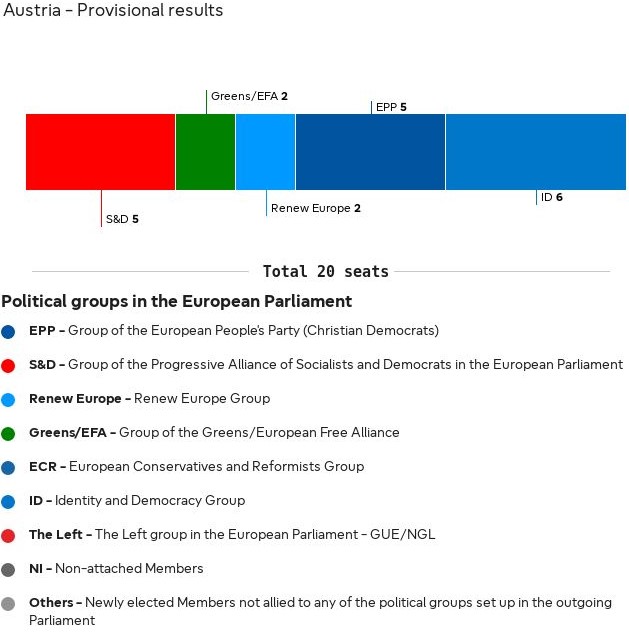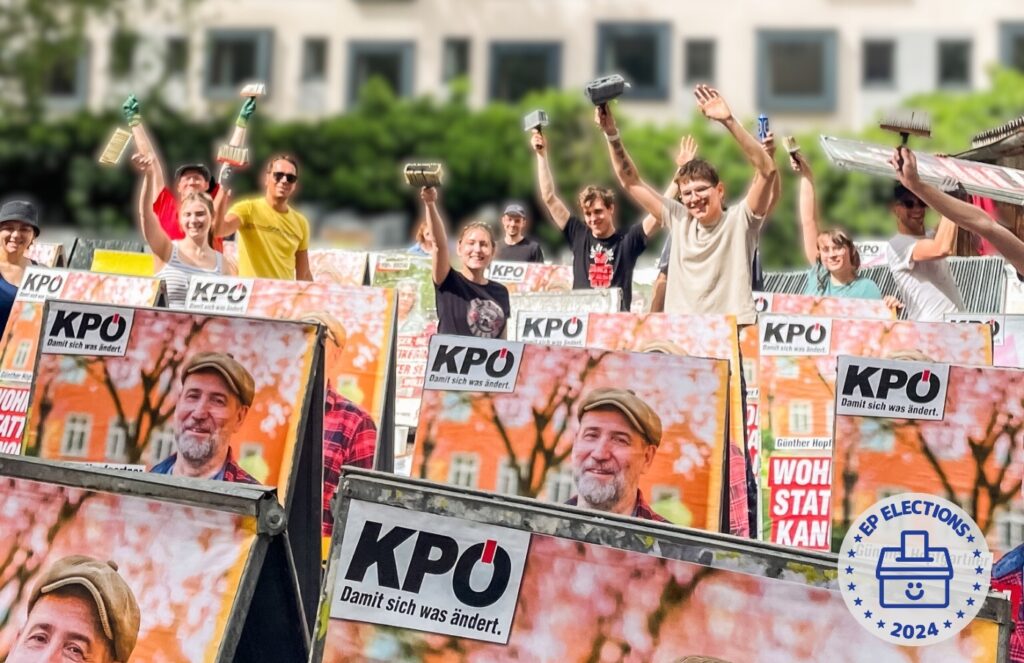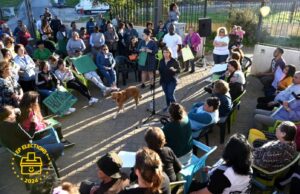In Austria’s recent European elections, the Communist Party (KPÖ) accomplished a remarkable surge, quadrupling its vote share. Although it hasn’t won any seat, its historic performance signals a potential revival of the left. As national elections approach, the KPÖ’s growing support, especially among young voters, offers a glimmer of hope for future parliamentary success.
In the European elections held on 9 June, 20 seats in the European Parliament (EP) were elected in Austria for the first time (since Brexit released the UK’s seats, which have been distributed among the remaining member states). The election – with 56.3% turnout, roughly the same as in previous EU elections – was unsurprising in terms of the parties’ rankings: in addition to the election victory of the extreme right, the Communist Party of Austria (KPÖ) quadrupled its previous vote share, even though this was not enough to secure a seat in the European Parliament.

Source: Verian for the European Parliament
(https://results.elections.europa.eu/en/national-results/austria/2024-2029/)
The right-wing extremist FPÖ emerged as the strongest party after the election. However, with 25.4% (plus 8.2%) and 6 mandates, it fell short of the forecasts, which had predicted up to 32% for the FPÖ, which is situated on the extreme right of the ID group of parties in the EP. It was followed by the conservative ÖVP, which belongs to the EPP, and suffered a major loss of 10% but still finished in second place with 24.5% and 5 seats. The Social Democratic Party (SPÖ, S&D), whose new leader had previously described himself as a “Marxist” but enjoys little support within the party, stabilised at 23.2% (down 0.7%) and will continue to send 5 representatives to the European Parliament. The Green Party’s election campaign was overshadowed by a scandal surrounding the credibility of its lead candidate, which dominated the headlines for weeks. Nevertheless, the party’s losses, which ultimately reached 11.1% and secured 2 mandates, were unexpectedly small at 3%. The SPÖ and the KPÖ profited from this but so did the neoliberal NEOS (Renew) party, which called for a “United States of Europe”, achieving 10.1% (up 1.7%) resulting in 2 mandates.
A Strong Sign of Revival for the Left
The KPÖ (EP group: The Left) achieved a historic result of 3% (up 2.2%) and almost 105,000 votes, which is four times as many as in the last European elections. It focused particularly on the issues of neutrality, peace, inflation, housing, and lobbying. The last time the party achieved a comparable result in a nationwide election was in 1962. In this election, the KPÖ was able to attract new voters everywhere, but the result in the capital Vienna is particularly noteworthy, where 4.7% (up 3.4%) would have been enough to cross the electoral threshold and enter the European Parliament. The election results in the party’s two regional strongholds, Graz (6.8 %; up 4.8%) and Salzburg (6.2%; up 4.8%), as well as in the other provincial capitals of Linz (4.7%; up 3.4%) and Innsbruck (4.4%; up 3.5%), contributed significantly to the nationwide growth. The fact that the sensational election results in the regional elections in Graz (28.8%) and Salzburg (23.1%) did not translate to the European level shows that the KPÖ still has work to do regarding supraregional elections. In any case, it seems encouraging for the future that the KPÖ received 10% of the under-30s, a similar level of support to that of the Greens (12%).
Voter Mobility
The voter flow analysis also shows the extent to which the KPÖ has been able to reach voters who were previously largely inaccessible: the party was able to attract 32,000 voters who opted for the Greens in the last EU elections, followed by 18,000 voters from the conservative ÖVP and 15,000 previous non-voters. It is also worth noting that 10,000 former voters of the extreme right were won over, while only 7,000 votes came from former SPÖ voters. This shows that the KPÖ’s strategy of convincing non-voters and FPÖ voters who are particularly socially disadvantaged has been partially successful. The KPÖ’s growth is therefore only to a small extent at the expense of the centre-left parties, which is encouraging with regard to the parliamentary elections, which will now take place on 29 September 2024, and it also calls into question the anti-communist propaganda of the established parties. This insight could potentially bring about a change in the media landscape, where the KPÖ has been given only a fraction of the coverage given to the other parties. The KPÖ was not invited to any of the many nationwide TV debates on state or private television, and it also had less presence in the left-liberal press than in the tabloids and conservative media.
Themed Failure in the Media During the Election Campaign
The choice of topics in the media and among the parties is also likely to have had an influence on the result: while the social upheaval caused by the inflation crisis was still the focus of media attention a few weeks ago, towards the end of the election campaign the topic of migration, for which the parties hardly have any constructive and rational answers, was increasingly pushed to the fore. While the population continues to struggle with rent increases of around 30% in recent years, the ÖVP and FPÖ in particular engaged in a racist duel. Towards the end of the election campaign, the conservative chancellor received his British counterpart in Vienna and then called for the implementation of the “Rwanda model”, which violates the European Convention on Human Rights, for the first time. The SPÖ, which supposedly has a left-wing leadership, also took the opportunity to call for the illegal deportation of refugees to Afghanistan and Syria. During this obfuscatory debate, it happened that large parts of southeastern Austria were submerged by floods, while Austria’s government is currently blocking the European Nature Restoration Law, aimed at restoring the natural river courses. The same can be said of the issue of war and peace, with the public debate fed by a logic of war, as is the case throughout Europe – despite Austria’s neutrality. For example, there was extensive discussion about arms deliveries to Ukraine, while Austria’s constitution actually prohibits such steps altogether. While the FPÖ – in line with its friendship treaty with the United Russia party – put up posters of the President of the European Commission kissing the Ukrainian President, it was left to the KPÖ to call for the revival of diplomacy for a ceasefire and the right of asylum for Russian and Ukrainian deserters. The other parliamentary parties have focused exclusively on military support for Ukraine in various shades, denouncing peace policy approaches as taking sides in the conflict. This hegemony of the logic of war also made it difficult for the KPÖ to convey its honest commitment to peace.
Parliamentary Elections in Autumn
This year, the political players in Austria will only be allowed a short summer break. As the national elections are scheduled for 29 September, the parliamentary parties will probably start their election campaigns in mid-August, but the KPÖ as an extra-parliamentary force, which had to collect 2,600 signatures to be on the ballot paper in the EP elections, will have to collect another 2,600 signatures from voters (which have to be done in person in front of the local authorities) by the beginning of July to be on the ballot paper in the national elections. The media have already declared the election campaign to be a three-way fight between the FPÖ, SPÖ and ÖVP, with the extreme right having declared for months that they want to make their leader the “Volkskanzler”, which is a direct reference to the National Socialist period. Consequently, all other parties are now distancing themselves from any participation in a government by the FPÖ. However, it is questionable whether this distancing will be maintained, especially in the case of the ÖVP, if its political leadership is replaced as a result of an expected election loss. There are also voices within the SPÖ suggesting that the party should cooperate with the neo-fascists in the future, although they are currently in the minority.
Looking at the KPÖ, the conditions that could allow it to become a parliamentary party seem more favourable than they have been for a long time. As early as autumn 2023, a party conference decided that the federal spokesperson Tobias Schweiger, a former official of the Green Youth from Styria, and Bettina Prohaska, a care worker from Salzburg, would form a dual leadership for the elections. With a different thematic focus in the media, the now united KPÖ, which focuses on social issues, health, and human rights, could succeed in taking the necessary second step. “We see our task as building trust with people who do not have a lot of money to make ends meet”, emphasised Schweiger after the election, pointing out that the party had only 50,000 euros available for the election campaign and was not invited to any TV debates. The KPÖ will continue its social counselling and support services after the elections. “It’s about having a concrete practical value for people, not dazzling election promises”, said Schweiger. In order to enter parliament in the autumn, the KPÖ must mobilise not that many more votes than it received this June and faintly reflect something of the high numbers it has received locally in Graz and Salzburg. Since the party only needs to win more than 4% of the votes nationwide or a direct mandate by winning a particularly large number of votes in a constituency, the chances of its re-entering parliament, 65 years after its departure, seem better than ever.
Cover photo source: KPÖ Facebook Account.



